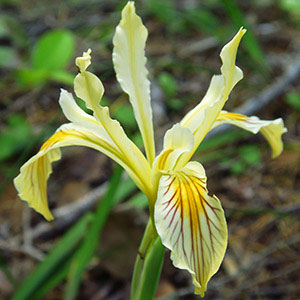Iris prismatica
Iris bracteata
slender blue iris
Siskiyou iris
superficial or only slightly buried in peaty soil, cordlike portions usually 1-branched, 40 cm × 2–5 mm, bearing scalelike leaves at nodes;
nodal roots absent.
sheathed with old leaf bases, slender, 0.6–0.9 cm diam.;
roots few, fibrous.
simple or 1–2-branched, 3–8 dm.
simple, solid, 1.5–3 dm.
basal with blade slightly ribbed, 3–6 dm × 0.2–0.5 cm;
cauline 1–4, erect.
basal with abaxial surface of blades deep glossy green on one side of fan, light yellow-green on other side, pink or red-tinged basally, strongly ribbed, 4–6 dm × 0.8–1 cm, rigid, margins not thickened;
cauline 3–6, imbricated, closely sheathing stem ca. 2/3 length, spreading distally, bractlike, blade inflated, often shorter than basal leaves.
1–3-flowered, branch units 1–2-flowered;
spathes pale brown, narrowly lanceolate, 2–4 cm, scarious or partially membranaceous.
simple, units 1–2-flowered;
spathes closed tightly around pedicel and ovary, lanceolate, 5.2–9 cm × 6–8 mm, subequal, herbaceous, margins scarious, apex acuminate.
perianth pale blue or blue-violet;
floral tube 0.2–0.3 cm;
sepals pale violet, veined deep violet basally, ovate, 4–5 × 1.3–2 cm, base abruptly attenuate;
petals lavender, oblanceolate, 3.5–4.5 × 0.7–1.5 cm;
ovary trigonal, sharply angled;
style arched, narrow, 2–3 cm, crests divergent, quadrate, 0.5–0.7 cm, margins serrate;
stigmas sharply triangular;
pedicel somewhat flattened, 3–7 cm, exserted from spathe.
perianth cream to buff-yellow;
floral tube 0.8–0.9 cm;
sepals with deeper yellow signal, veined with purple or brown, obovate-lanceolate, 6.5 × 2.5 cm, base gradually attenuate into wide claw;
petals narrowly oblanceolate, 7–9 × 0.8–2 cm, base gradually attenuate;
ovary nearly circular in cross section, 1.5–2.5 cm, base gradually attenuate into pedicel, apex abruptly acuminate into floral tube;
style 2.2–3 cm, crests spreading, yellow, not veined, 1.2 × 0.9–1.7 cm, margins toothed;
stigmas triangular or tongue-shaped, margins entire;
pedicel 3–6.2 cm.
sharply 3-angled, almost winged, 3–4 × 1.2–1.4 cm, concave faces 6–14 mm wide.
nearly circular in cross section, tapering abruptly at each end, 2–2.5 × 1–1.5 cm.
in 1 row per locule, buff to dark brown, pyriform, with convex sides, 3–4 mm, smooth.
dark brown, irregular in shape, wrinkled.
= 42.
= 40.
Iris prismatica
Iris bracteata
Iris bracteata is limited to one county each in northern California and southern Oregon. It hybridizes with I. chrysophylla, I. douglasiana, I. innominata, I. munzii, I. purdyi, and I. tenax.
(Discussion copyrighted by Flora of North America; reprinted with permission.)


